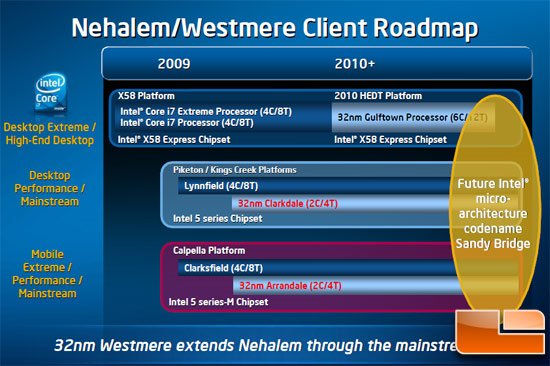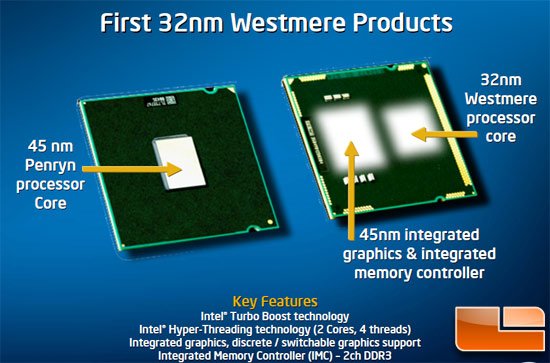Here's a look at some of the interesting things:
Here's a peek at Intel's Nehalem and Westmere plans for the consumer markets. Nehalem technology will go mainstream this year, first Intel will debut the 45nm quad-core, 8 threaded Lynnfield and Clarksfield and the 32nm dual-core, 4-threaded Clarkdale and Arrandale will follow later. Intel didn't talk about quad-core Westmere processors, perhaps this segment will continue to be served by Lynnfield and Clarksfield until the 32nm Sandy Bridge architecture arrives.Intel demonstrated the first working 32nm desktop and notebook processors at a briefing. The first 32nm processors from Intel will enter production in Q4 2009, these chips are codenamed Clarkdale (desktop) and Arrandale (notebook). The Tick-Tock model remains intact. Westmere is the 32nm shrink of Nehalem and a new 32nm architecture named Sandy Bridge will be the next tock. The low-end dual-core 45nm Havendale and Auburndale Nehalem parts may indeed be cancelled, as 32nm is doing so well. This implies all Nehalem processors may be quad-core. Enthusiasts can expect Gulftown near the end of 2009 or early 2010, this 32nm Westmere chip will have 6 cores and 12 threads. Westmere will introduce seven Advanced Encryption Standard (AES) instructions to speedup encryption and decryption algorithms. This will be very useful for full disk encryption technology.

The Westmere platform features a two chip solution, the processor integrates the IGP and memory controller, and the ICH has been eliminated. This lowers costs and saves space on the motherboard. The Westmere chips will use a multi-chip design, the processor core is 32nm but the integrated graphics and memory controller are still 45nm. Intel stated the integrated graphics of Westmere is a shrink of their 65nm integrated graphics with some performance tweaks.
